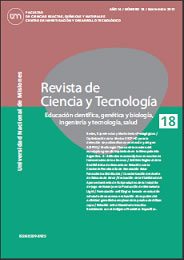Formulación antifúngica basada en solución saturada de sacarosa: evaluación de su potencial actividad genotóxica empleando la prueba de Allium cepa
Contenido principal del artículo
Resumen
En el presente trabajo, los potenciales efectos genotóxicos de la formulación antifúngica basada en la solución saturada de sacarosa fueron evaluados utilizando la Prueba de Allium cepa. Se evaluaron por duplicado cinco tiempos de exposición empleando agua mineral como control. Para el análisis estadístico, se empleó un análisis de varianza (ANOVA) y una prueba a-posteriori de Tukey HSD (significación estadística α = 0,05). Las frecuencias de las anomalías cromosómicas observadas partieron desde 0% a 0,24% y el análisis estadístico de las frecuencias de anomalías cromosómicas reveló que no se detectaron diferencias estadísticamente significativas en relación con los controles. Se concluye que la formulación antifúngica en base a solución saturada de sacarosa no evidenció una actividad genotóxica al evaluarse los resultados del presente trabajo empleando la prueba de Allium cepa.
Descargas
Detalles del artículo
La Revista de Ciencia y Tecnología sostiene su compromiso con las políticas de Acceso Abierto a la información científica, al considerar que tanto las publicaciones científicas como las investigaciones financiadas con fondos públicos deben circular en Internet en forma libre y gratuita. Los trabajos publicados en la Revista de Ciencia y Tecnología están bajo la licencia Creative Commons Atribución-NoComercial 2.5 Argentina.
Citas
Brennan, B. and James, J., Overview of topical therapy for common superficial fungal infections and the role of new topical agents, J. Amer Acad Dermat 36: p S3-8. 1997.
Sangeorzan, J.; Bradley, S., He, X.; Zarins, L.; Ridenour, G.; Tiballi, R and Kauffman, C., Epidemiology of Oral Candidiasis in HIV-Infected Patients: Colonization, Infection, Treatment, and Emergence of Fluconazole Resistance. Amer J. Medicine 97: p 339-346. 1994.
Moshi, M.; van den Beukelb, C.; Hamzac, O.; Mbwamboa, Z.; Nondoa, R.; Masimbaa, P.; Mateed, M.; Kapingua, M.; Mikxf, F.; Verweije, P. and van der Venb, A., Brine Shrimp Toxicity Evaluation of Some Tanzanian Plants Used Traditionally for the Treatment of fungal infections. African J. Tradit 4: p 219-225. 2007.
Reca, M; Medvedeff, M.; Vedoya, M. and Herszage, L., Estudio in vitro de la inhibición del crecimiento de hongos por solución sobresaturada de azúcar. VI Cong Arg Mic 6: 1-76. 1993
Medvedeff, M.; Lloret, M.; Vedoya, M.; Reca, M. and Herszage, L., Estudio in vitro de la acción fungicida del eugenol en solución sobresaturada de azúcar. Rev Arg Mic 20: p. 46-52. 1997.
Medvedeff, M.; Lloret, M.; Vedoya, M.; Zanek, M. and Herszage, L., Efecto fungicida de la solución saturada de azúcar, eugenol y polietilenglicol 400 sobre Candida albicans. Rev Arg Mic 21: p 14-17. 1998.
Medvedeff, M.; Vedoya, M.; Lloret, M.; Espinola, M. and Herszage, L., Saturated saccharose solution (SSS), its in vitro and in vivo action on Paecilomyces lilacinus. Rev Iberoamer Mic 17: S160-161. 2000ª.
Medvedeff, M.; Vedoya, M.; Lloret, M.; Espinola, M. and Herszage, L., Bioactividad de la solución saturada de sacarosa sobre Sporothrix schenkii. Rev Iberoamer Mic 17: p. 146-148. 2000b
Fatima, R. and Ahmad, M., Genotoxicity of industrial wastewaters obtained from two different pollution sources in northern India: A comparison of three bioassays. Mutat Res 609: p 81–91. 2006.
Siddiqui, A.; Tabresz, S. and Ahmad, M., Validation of plant based bioassays for the toxicity testing of Indian waters. Environ Monitoring Assessm 179: p 241–253. 2011.
Ma, T., The international Program on Plant Bioassays and the Report of The Follow-up Study After the Hands-on Workshop in China. Mutat Res 426: p 103-106. 1999.
Barbério, A.; Barrios, L.; Voltolini, J. and Mello, M., Evaluation of the cytotoxic and genotoxic potential of water from the River Paraíba do Sul, in Brazil, with the Allium cepa L. test. Braz. J. Biol. 69: p 837-842. 2009.
Morais, D. and Marin-Morales, M., Allium cepa test in environmental monitoring: A review on its application. Mutat Res 682: p 71–81. 2009.
De Rainho, C.; Kaezer, A.; Aiub, C. and Felzenszwalb, I., Ability of Allim cepa L. root tips and Tradescantia pallida var. purpurea in N-nitrosodiethylamine genotoxicity and mutagenicity evaluation. Anais Acad Bras Cien 82: p 925-932. 2010.
Fiskesjö, G. The Allium test as a standard in environmental monitoring. Hered 102: p 99-112. 1985.
Monte, L.; Medeiros, M.; Batistuzzo, S. and Agnez-Lima L., Cytotoxic and genotoxic potential of surface water from the Pitimbu river, northeastern/RN Brazil. Genetics Mol Biol 30: p 435-441. 2007.
Grant, W. Chromosome aberration assays in Allium: A report of the U.S. Environmental Protection Agency Gene-Tox Program. Mutat Res 99: p 273-291. 1982.
Aydemir, N.; Celikler, S.; Summak, S.; Yilmaz, D. and Ozer, O. Evaluation of Clastogenicity of 4,6-Dinitro-o-cresol (DNOC) in Allium Root tip Test. J. Biol. Environ. Sci. 2: p 59-63. 2008.
Gentile, J.; Wagner, E. and Plewa, M., The Detection Of Weak Recombinogenic Activities In The Herbicides Alachlor And Propachlor Using A Plant-Activation Bioassay. Mutat Res 48: p 113-116. 1977.
Menn, J., Comparative Aspects of pesticide Metabolism in plants and animals. Environ Health Perspec 27: p 113-124. 1978.
Fiskesjö, G., The Allim test – an alternative in environmental studies: the relative toxicity of metal ions. Mutat Res 197: p 243-260. 1988.
Rank, J. and Nielsen, M., Allium cepa anaphase-telophase root tip chromosome aberration assay on N-methyl-N-nitrosourea, malei hydrazide, sodium azide, and ethyl methanesulfonate. Mutat Res 390: p 121-127. 1997.

